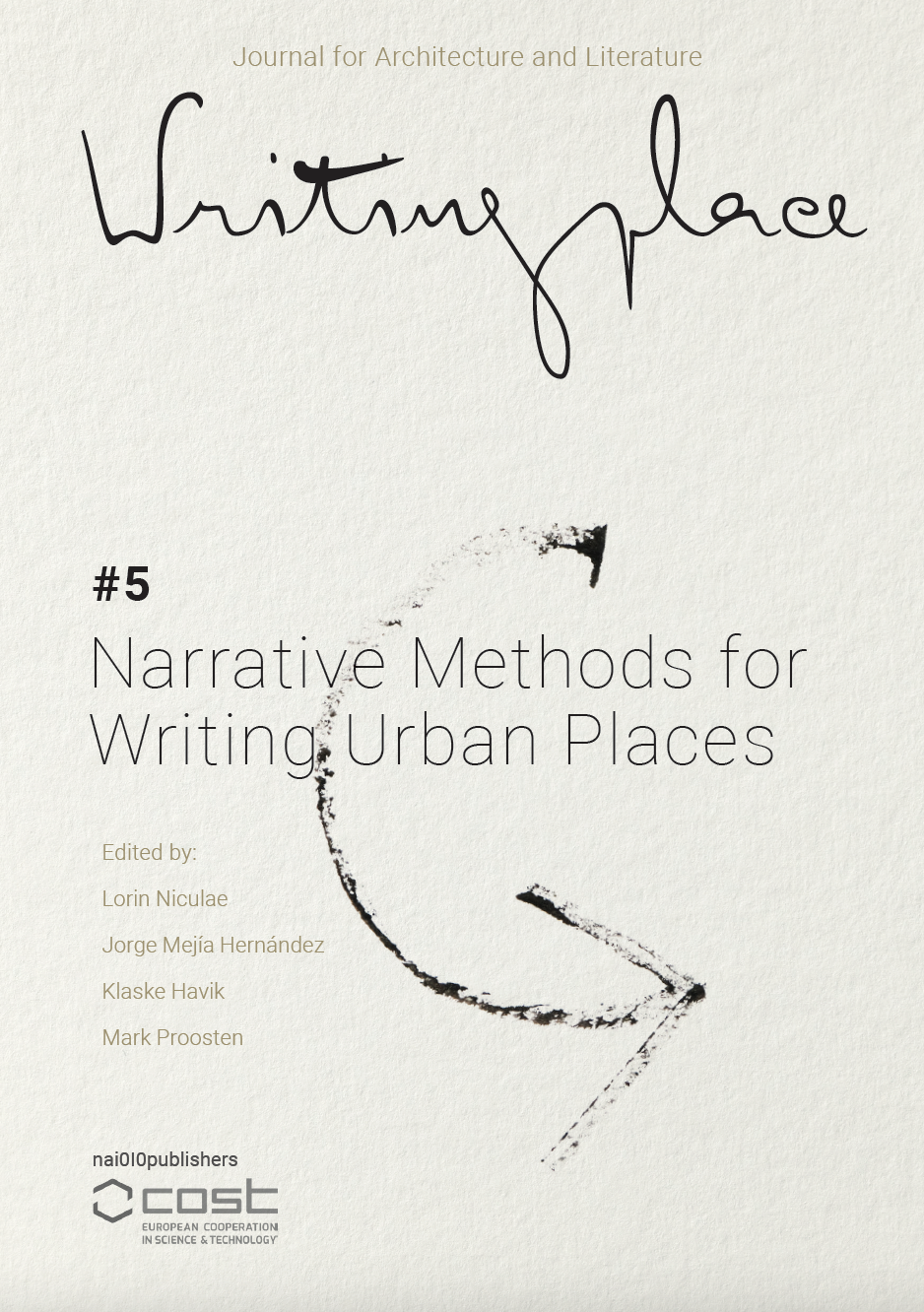The Paris of L’Ivre De Pierres, Narrative Architecture between Words and Drawing
DOI:
https://doi.org/10.7480/writingplace.5.5874Keywords:
Drawing, Narrative, Architectural reveries, Paper architecture, UtopiaAbstract
An editorial experiment pursued by Jean-Paul Jungmann between 1977 and 1983, L’Ivre de Pierres provides a series of imaginary visions, mostly of an imaginary Paris, conceived through architectural narrations that were articulated in the pages of a book. This article examines L’Ivre de Pierres’ unconventional approach to figurative writing, as an example of the possibilities of exploring architecture through narrative means, constructing urban narratives through architectural design, and developing architectural criticism through both. L’Ivre de Pierres did not renounce the project in favour of discourse, but employed architectural devices to elaborate a ‘concrete utopia’ instead: one made of potentially realizable projects which, however, were conceived to exist only as (real) fictions in the pages of a book. Firmly rooted in Jungmann’s previous experience with the magazine Utopie, with which it somehow plays a game of mirrors, L’Ivre de Pierres is also linked to the tradition of paper architecture that historically used fiction to produce architectural discourses, criticism, or to think architectural designs. This article researches on the narrative methods and modes – it examines the iconography, the book format, the content and types of texts – used in L’Ivre de Pierres as an example of the potential that these both visual and textual alternative realities have for the reading, thinking and writing of urban places.
References
Jean-Paul Jungmann and Hubert Tonka, La Città Policentrica. Paris/Parme. L’Ivre de Pierres – Vaisseau de Pierres, poster with text for a congress in Nocetto/Parma in April 1984.
Craig Buckley, ‘Introduction: The Echo of Utopia’, in: Craig Buckley and Jean-Louis Violeau (eds.), Utopie: texts and projects 1967-1978 (Cambridge, MA: MIT Press, 2011), 13.
Jean-Paul Jungmann. Interviewed by the authors, 28 May 2015.
Buckley, ‘Introduction’, op. cit. (note 3), 12.
Utopie, ‘Des raisons de l’architecture’, L’Architecture d’Aujourd’hui 138 (1968), 124-145.
Henri Lefebvre, Le Temps des méprises (Paris: Stock, 1975).
Jean Baudrillard, ‘Utopie dialectique’, Utopie 1 (1967), 55.
Jean Aubert interviewed in: Beatriz Colomina and Craig Buckley (eds.), Clip/Stamp/Fold: The Radical Architecture of Little Magazines, 196X to 197X (Barcelona: Actar, 2010), 196.
Hubert Tonka, ‘L’Ivre d’Encres’, L’Ivre de Pierres 1 (1977), 7.
Jean-Paul Jungmann, ‘Histoires à Editer’, in: Hubert Tonka (ed.), Le Guide du Paris de L’Ivre de Pierres (Paris: Musée d’Art Moderne de la Ville de Paris/ARC, 1982), 15.
Jean-Paul Jungmann, ‘Écrire un projet est racconter la ville’, in: Jean-Paul Jungmann and Hubert Tonka (eds.), L’Ivre de Pierres chez Cl.-N. Ledoux (Paris: Aérolande, 1984), 3.
Jean-Paul Jungmann, L’Image en Architecture – de la représentation et de son empreinte utopique (Paris: Éditions La Villette, 1996).
Jungmann, Les Années L’Ivre de Pierres. À la recherche d’une Architecture possible [1975-1986] (Paris: Sens&Tonka, 2020), 55.
Tonka, ‘L’Ivre d’Encres’, op. cit. (note 11).
Jean-Paul Jungmann, interviewed in: Colomina and Buckley, op. cit. (note 10), 352.
Some authors, like Peter Wilson in ‘Le Pont des Arts’ (LIDP 4), rejected classic perspectives, opting for different yet highly expressive points of view.
William S. Saunders, ‘Rem Koolhaas’s Writing on Cities: Poetic Perception and Gnomic Fantasy’, Journal of Architectural Education 51/1 (1997), 61.
Aérolande in La Città Policentrica. Paris/Parme. L’Ivre de Pierres – Vaisseau de Pierres, on occasion of a congress in Nocetto/Parma in April 1984.
Jean Aubert in: Colomina and Buckly, op. cit. (note 10), 196.
Henri Lefebvre, Le droit à la ville (Paris: Anthropos, 1968).
Jean Critton, ‘Opera des Halles, projet scénographique pour l’aménagement des Halles’ and ‘Phénomène de parthénogénèse architecturale au Forum des Halles’, L’Ivre de Pierres 3 (1980), 33-55.
‘De l’espace tropologique: un premier crayon de mausolées pour la place de la Concorde, par Jean-Jacques Lequeu, le 15 janvier 1815, restauré par Philippe Duboy. and Un forum au coeur du Paris révolutionnaire. Le projet de Théâtre des Arts de Charles de Wailly, 1798’, introduced by Daniel Rabreau, L’Ivre de Pierres 1 (1977).
Jean-Paul Jungmann, in: Jean Dethier (ed.), Images et imaginaires d’architecture, dessin, peinture, photographie, arts graphiques, théâtre, cinéma en Europe aux XIXe et XXe siècles, exhibition catalogue (Paris: Centre Georges Pompidou, 1984), 140.
François Herrenschmidt, ‘Dialogue sur l’Utopie d’Hier et la Verité d’Aujourd’hui’, in: Tonka, Le Guide du Paris, op. cit. (note 12), 131.
Antoine Chauvin, ‘Le Pari(s) de Jean-Paul Jungmann: Étude de sept projets théoriques pour la ville de Paris’, Mémoire de Master en Histoire de l’Architecture, Université Paris I (2014), 43.
Émile Zola, The Belly of Paris (Oxford World’s Classics, 2007 [1873]), 25.
Jean Aubert, ‘Le Square des égoutiers’, L’Ivre de Pierres 2 (1978), 7.
Jean-Paul Jungmann’s monumental ‘La gare vers l’Est’, L’Ivre de Pierres 3 (1980).
Downloads
Published
How to Cite
Issue
Section
License
Copyright (c) 2021 Carlos Machado e Moura, Luis Miguel Lus Arana

This work is licensed under a Creative Commons Attribution 4.0 International License.



